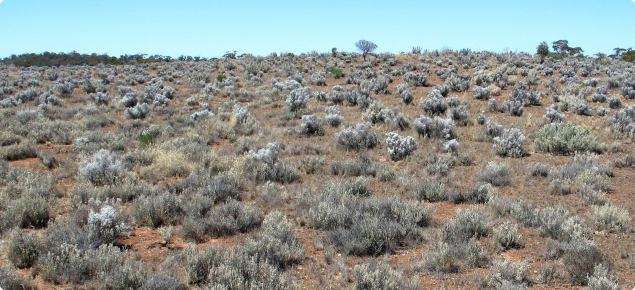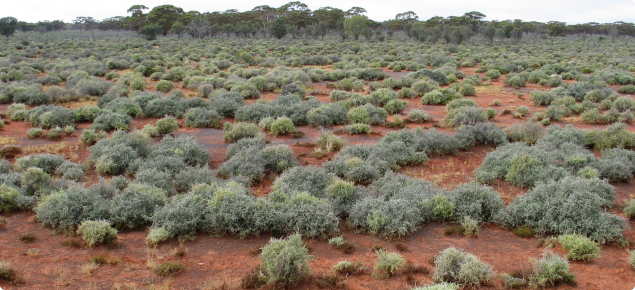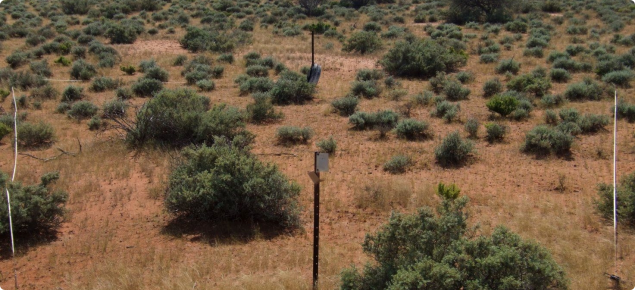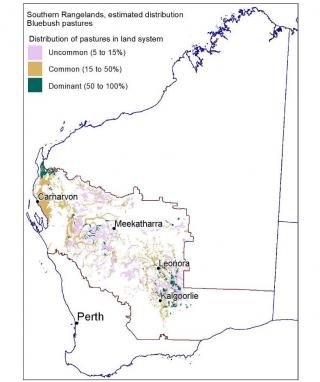Pastoral value – high
Bluebush pastures in good condition have a high pastoral value, are a drought durable, reliable, high quality (15–23% protein), year-round food source for stock, especially when annual feed is scarce or absent. Good quality water supplies must be provided to maximise pasture utilisation and animal productivity.
Perennial bluebushes are extremely long lived and durable shrubs. However, if they have been grazed out, they can take many years to return to the landscape.
Pasture type variation in the bluebush pastures group
Different pasture types (for example, pearl bluebush community pastures, sago bush shrubland pastures) will have different pastoral value, and the pastoral value will change with rainfall and other factors.
Suggested levels of use (per annum)
Table 1 provides a rough guide to the range of pastoral values for good condition pastures, which must be checked against conditions in each region and paddock. Carrying capacities for fair condition pastures might be 75% to 50% of good, and poor condition pastures less than 50% of good.
See Introduction to pastures in the southern rangelands of Western Australia for an explanation of how carrying capacities are estimated.
| Condition | Carrying capacity ha/DSE1 | Carrying capacity ha/CU2 (ha/AE3) |
|---|---|---|
| Good | 5.1–9.9 | 36–69 (43–83)) |
1 DSE is based on the feed energy required to maintain a 45 kilogram liveweight Merino wether with zero weight change, no wool growth additional to that included in maintenance, and walking 7 km/day. 1 DSE has an energy requirement of approximately 8.7 MJ ME/day.
2 CU in the southern rangelands is based on a 400 kg steer at maintenance and equivalent to 7 DSE.
3 AE is based on the feed energy to maintain a 450 kg Bos taurus steer 2.25 years of age, walking 7 kilometers each day. 1 AE has an energy requirement of approximately 73 MJ ME/day and equivalent to 8.4 DSE.
Managing bluebush pastures
Combinations of strategic fencing, adequate distribution of good quality water, conservative stocking rates and spelling can maintain or improve the condition of bluebush pastures.
- Complete spelling can improve pasture condition after a major recruitment event.
- Occasional spelling to take advantage of summer rainfall for germination and recruitment of young plants is necessary to maintain a viable age structure.
- Regular winter spelling is recommended for maintenance of vigour.
- Opportunistic grazing of annual growth can be employed in fair condition pastures in a good season.
- Cultivation and reseeding followed by complete spelling may be required where few perennials remain.
Bluebush pastures, regardless of condition, may support fuel loads from annuals and ephemerals sufficient to carry fires following above-average growing seasons. Increased susceptibility to wildfire is a significant threat to these pastures, with burning likely to have detrimental consequences for future pasture productivity.
Some extensive areas formerly supporting bluebush pasture are now so degraded the likelihood of any recovery of palatable bluebushes is limited. The recommended stocking rate for annual-only pastures to have a chance of recovery is very low (>30 ha/DSE). There is no grazing value in very poor condition bluebush pastures without perennial plants to support stock during dry seasons. Annual-only pastures are not viable for commercial pastoralism.
Degraded areas may produce prolific annual herbage in good seasons, but have no dry-season durability.
Bluebush pastures in fair to poor condition may support fuel loads sufficient to carry fires following above average growing seasons and growth of annual species. Wildfire in that situation contributes to more degradation of those pastures.
Pasture condition
Most bluebush pastures are severely degraded due to overgrazing. These pastures may never be restored if the soil surface has eroded. Pastoral value in severely degraded bluebush pastures is far below the potential.
Good condition
See Figures 1, 4, 7. Palatable bluebushes dominate with an even cover of vigorous and robust mature and young plants. Projected foliar cover (PFC) is usually 5–20%, or better in good seasons. Another indicator of good condition is the presence of desirable saltbushes.
Disappearance of the preferentially grazed desirable bluebush and saltbush species is an early-warning indication of pasture condition decline. Change in bluebush pastures can be quite subtle. For instance, shy bluebush is very palatable when present, and will be preferentially grazed, leaving no sign of degradation in other plant species.
Moderately palatable species such as cotton bush sometimes make a significant contribution to plant density. Undesirable species such as cassias and needle bush may be present at low densities.
When these pastures are in good condition, the soil surface is stable, with an abundance of cryptogamic crusts assisting vegetation to provide protection from wind and water erosion. No erosion is present.
Fair condition
See Figures 2, 5, 8. A reduction in the density of the dominant desirable bluebush and other low shrubs is a decline in pasture condition from good to fair shown as reduced shrub cover. PFC is generally within the range of 5–10%, but may be as low as 2.5%. The most palatable perennial shrubs will become rare or absent.
Decline in bluebush density usually generates an increase in seasonal growth of annuals and ephemerals, in the increased space between the desirable shrubs. The density of moderately palatable and undesirable plants will tend to remain the same as in good condition pastures but the increased prominence of the unpalatable species is symptomatic. Minor erosion may be evident.
The slow recovery process associated with fair and poor condition bluebush pastures serves as incentive to manage fair condition pastures conservatively and reduce the risk of further decline.
Poor condition
See Figures 3, 6, 9. Poor condition is characterised by very low perennial shrub cover, bare areas and often a moderate density of undesirable species. The density of the dominant desirable bluebush is low. Established bluebush plants may show very poor vigour, often grazed right back to the unpalatable woody material.
Perennial species may be completely absent in very poor condition. Scalding and hummocking caused by the wind is common in poor condition bluebush pastures, with water erosion and perennial plant loss the primary factors leading to serious soil degradation.
Bluebush pastures, regardless of condition, may support fuel loads from annuals and ephemerals sufficient to carry fires following above-average growing seasons. Increased susceptibility to wildfire is a significant threat to these pastures, with burning likely to have detrimental consequences for future pasture productivity.
Some extensive areas formerly supporting bluebush pasture are now so degraded that recovery of palatable bluebushes is limited. The recommended stocking rate for annual-only pastures to have a chance of recovery is very low (>30 ha/DSE). In dry seasons, there is no grazing value in very poor condition bluebush pastures lacking perennial plants. Annual-only pastures are not viable for commercial pastoralism.
Pearl bluebush community condition photographs
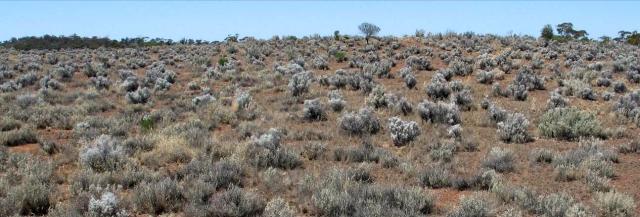


Sago bush shrubland condition photographs



Gascoyne bluebush pasture condition photographs


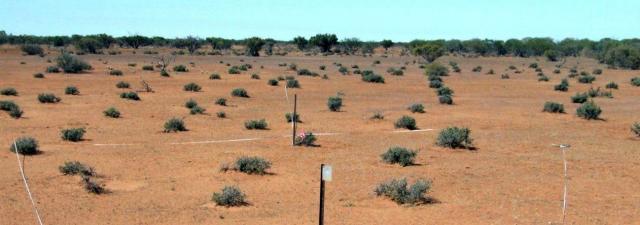
Vegetation structure and composition
Low shrubs (<1m) with projected foliar cover (PFC) ranging from <2 to 20%; composition is very variable and a function of position in the landscape, geography, soil salinity and past use. Some bluebush pastures have a prominent overstorey of tall shrubs, and occasionally appear as scattered woodlands and, in severely degraded areas, as herb fields (PFC <2%).
No single species of bluebush is distributed over the entire southern rangelands. Pearl bluebush is common throughout the Goldfields and Nullarbor, while Gascoyne bluebush is restricted to the Gascoyne district. Flat-leaved bluebush and three-winged bluebush are widely distributed over areas north of Kalgoorlie. Most bluebush pastures in the Murchison district are dominated by sago bush.
Occurrence
Bluebush pastures occur on saline soils on level plains, river and lake frontages and on the Nullarbor Plain, covering an estimated 1.74 Mha (2.1% of the southern rangelands).
Crystals of salt may be visible on the soil surface or on some plant stems. The soil surface may be puffy under a thin crust. Saline soils indicate that saltbushes or bluebushes should be or once were present.
Associated plants
| Common name | Scientific name (links to FloraBase) | Desirability* |
|---|---|---|
| Ball leaf bluebush | D | |
| D | ||
| D | ||
| Feather speargrass | D | |
| D | ||
| D | ||
| D | ||
| Golden bluebush, George's bluebush | D | |
| Green cassia | D | |
| Sage, Australian sage | D | |
| D | ||
| Silky bluebush | D | |
| D | ||
| Spiny bluebush | D | |
| D | ||
| D | ||
| U | ||
| U | ||
| Cassias | U | |
| Flannel bush | U | |
| U | ||
| Silver poverty bush | U | |
| Straight leaf cassia, variable cassia | U | |
| U | ||
| Wait-a-while | U | |
| Curara, Kurara | I | |
| False bluebush | I | |
| Gascoyne mulla mulla | I | |
| Granite poverty bush | I | |
| Lovegrasses | I | |
| Mulga1 | I | |
| I | ||
| I | ||
| I | ||
| Western myall | I | |
| I | ||
| Woolly poverty bush | I |
1 Mulga as Acacia aneura has been split into multiple species including: A. aneura, A. aptaneura, A. caesaneura, A. fuscaneura, A. incurvaneura, A. macraneura, A. mulganeura, A. pteraneura.
* D = desirable, U = undesirable, I = intermediate, N = no indicator value

